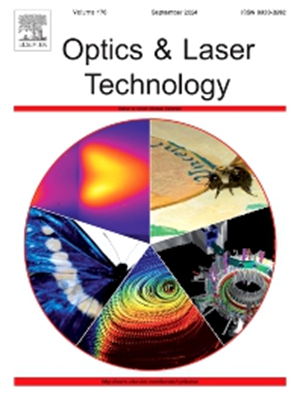铥光纤激光碎石治疗肾结石的热模型
IF 5
2区 物理与天体物理
Q1 OPTICS
引用次数: 0
摘要
本文用有限元方法建立了脉冲铥光纤激光碎石机的热模型。我们模拟了肾结石(一水氧化钙)的温度和蒸发速率。当激光能量从35 mJ增加到50 mJ时,蒸发速率从131µg/s增加到1118µg/s。此外,我们还研究了脉冲重复频率对蒸发速率的影响。当脉冲重复频率从10 Hz增加到100 Hz时,35 mJ的蒸发速率从21 μg/s显著增加到131 μg/s。我们的模拟结果与文献中的实验结果非常吻合。此外,模拟显示肾结石的充水微孔温度达到5000 K,其余部分温度达到2600 K。这种巨大的变化是由于水中对辐射的强烈吸收。微孔内过热蒸汽的压力比肾结石的机械强度高2.6倍,导致结石微爆炸。本研究还揭示了热应激在肾结石碎裂中起着至关重要的作用。对泌尿科医生来说,退推效应是一个众所周知的碎石问题。我们估计了退推距离,发现在本研究中使用的激光设置下它可以忽略不计。本文章由计算机程序翻译,如有差异,请以英文原文为准。
A thermal model on thulium fiber laser lithotripsy of kidney stone
The paper presents a thermal model for pulsed thulium fiber laser lithotripsy using the finite element method. We simulated the temperature and vaporization rate of kidney stones (calcium oxide monohydrate). When the laser energy increased from 35 mJ to 50 mJ, the vaporization rate increased from 131 µg/s to 1118 µg/s. Additionally, we investigated the effect of the pulse repetition rate on the vaporization rate. The vaporization rate increased significantly from 21 μg/s to 131 μg/s for 35 mJ when the pulse repetition rate increased from 10 Hz to 100 Hz. Our simulated results are in excellent agreement with the experimental results available in the literature. Further, the simulation showed that the water-filled micropores of kidney stones achieved a temperature of 5000 K while its remaining part gained 2600 K. This large variation is due to the strong absorption of radiation in water. The pressure of the superheated vapor inside the micropores is 2.6 times higher than the mechanical strength of kidney stones, which leads to a microexplosion of stone. This study also revealed that the thermal stress would play a crucial role in the fragmentation of kidney stones. The retropulsion effect is a well-known lithotripsy issue for urologists. We estimated the retropulsion distance and found it to be negligible under the laser settings used in the present study.
求助全文
通过发布文献求助,成功后即可免费获取论文全文。
去求助
来源期刊
CiteScore
8.50
自引率
10.00%
发文量
1060
审稿时长
3.4 months
期刊介绍:
Optics & Laser Technology aims to provide a vehicle for the publication of a broad range of high quality research and review papers in those fields of scientific and engineering research appertaining to the development and application of the technology of optics and lasers. Papers describing original work in these areas are submitted to rigorous refereeing prior to acceptance for publication.
The scope of Optics & Laser Technology encompasses, but is not restricted to, the following areas:
•development in all types of lasers
•developments in optoelectronic devices and photonics
•developments in new photonics and optical concepts
•developments in conventional optics, optical instruments and components
•techniques of optical metrology, including interferometry and optical fibre sensors
•LIDAR and other non-contact optical measurement techniques, including optical methods in heat and fluid flow
•applications of lasers to materials processing, optical NDT display (including holography) and optical communication
•research and development in the field of laser safety including studies of hazards resulting from the applications of lasers (laser safety, hazards of laser fume)
•developments in optical computing and optical information processing
•developments in new optical materials
•developments in new optical characterization methods and techniques
•developments in quantum optics
•developments in light assisted micro and nanofabrication methods and techniques
•developments in nanophotonics and biophotonics
•developments in imaging processing and systems

 求助内容:
求助内容: 应助结果提醒方式:
应助结果提醒方式:


